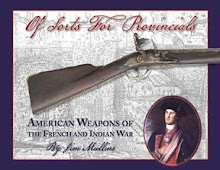An early 19th century image showing a red cloth gun case from:
http://colonialbaker.net/milice_pictures.html
As we go down the list of items for our DIY Va backcountry kit build, we come to a fairly difficult to document item, the gun sack or gun case (perhaps a useful thing on horseback and foul weather?).
From the David Hastings' (Hastings) inventory:
http://www.danielhaston.com/people/david-hastings-died1776.htm
"1 Gun Case"
from the Militia Roster of Capt. Shelby:
http://www.tngenweb.org/revwar/counties/sullivan1779.html
"1 gun sack"
Jason Isham, writing to London, 1743
"June 24, 1743: the guns are bad, Let us trade light Guns small in the hand, and we'll shap'd with Locks that will not freeze in the winter and Red gun cases, (for if a gun is bad, a fine case oft'n puts it of, being admirers of different colours)."
*Trade Guns of the Hudson's Bay Company 1670-1970 by S. James Gooding
viaRich, E.E (ed.) McLaughlins Fort Vancouver Letters, 1839 - 1844. Toronto. The Champlain Society, 1943.
From the Henry Laurens Papers: "a fowling piece under a Woolen cover"
(p584 Laurens to William Penn letter dated 2d June 1769).
"A woollen case for the Gun, thread & making- 2.. 6 "
and from The Papers of Archibald D. Murphey: we get to mounted use of a "boot" (thanks to Steve R for this quote and some of the image leads!)
http://books.google.com/books?pg=PA255&dq=shot%20bag%20%2B%20belt&ei=iw5cTOviCIH_8Aasn8DeAQ&ct=result&id=7DYTAAAAYAAJ&output=text
As soon as Genl. Davidson was advised of the British army again advancing, he ordered out the next detachment which was detailed for duty from the counties1 under his command to rendezvous between Charlotte and the Catawba River. On the 19th, he received information of Tarlton's defeat at Cowpens. On the 21st a party of twenty Whigs who lived in the country South-East of the Cowpens (but had not been in the fight) brought into our camp twenty-eight prisoners, British stragglers, whom they had taken, most of whom were wounded—they were sent on eastwardly the same day. Genl. Davidson being advised of the rapid advance of the British army, and the Troops joining him, being all infantry, and Genl. Greene having appointed Col. Davie to superintend the commissariat department, directed Adjutant Graham, who had now recovered of his wounds received in advance of Charlotte on the 26th September to raise a company of Cavalry, promising that those who furnished their own horses and equipments and served six weeks, should be considered as having served a tour of three months, the term of duty, required by law. In a few days he succeeded in raising a company of fifty-six, mostly enterprising young men, who had seen service, but found it difficult to procure arms. Only fortyfive swords could be produced, and one half of them were made by the country Blacksmiths. Only fifteen had pistols, but they all had rifles. They carried the muzzle in a small boot, fastened beside the right stirrup leather, and the butt ran through the shot bag belt, so that the lock came directly under the right arm. Those who had a pistol, carried it, swung by a strap, about the size, of a bridle rein, on the left side, over the sword,
This boot likely looked something like the one from this image of the 10th Light Dragoons by Stubbs:
http://www.terminartors.com/artworkprofile/Stubbs_George-Soldiers_of_the_10th_Light_Dragoons
As for the conjectural repros- we have a few period images to review:
Diderot's Trunk maker (see top left, likely leather):
Zoffany provides us with another look (likely a textile) c1765:
http://www.huntsearch.gla.ac.uk/cgi-bin/foxweb/huntsearch/DetailedResults.fwx?collection=hunter&SearchTerm=9196&mdaCode=GLAHA&reqMethod=Link&browseMode=on
Further info can be found in an article entitled PRIMARY SOURCE DOCUMENTATION FOR MUSKET AND RIFLE CASES Compiled by Joseph Ruckman that is in the files section of Rev List, which includes further citations on leather and woolen cases (includes French and English citations both before and after our target date of the third quarter of the 18th century).
For my conjectural reconstruction, I chose a case of wool sized for my gun (I'd suggest sticking with the very common white, blue or red wool barring documentation to the contrary)- basically a long rectangle with one end left open that could be tied shut with a bit of tape or string. I back stitched the cloth with linen thread, turned that inside out and then secured the openings for the string with a coarse button hole stitch.

